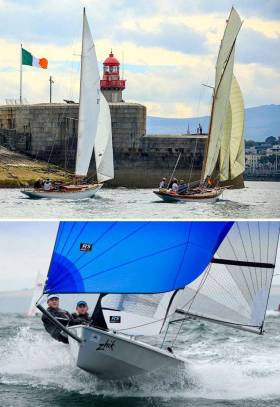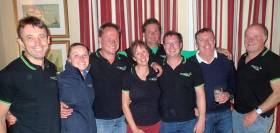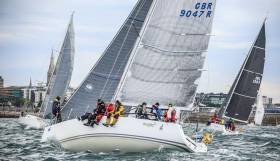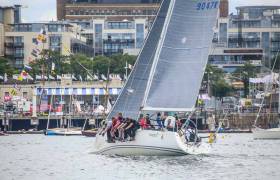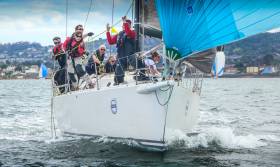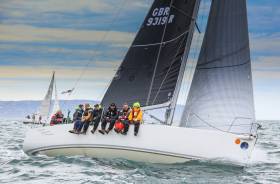Displaying items by tag: ISORA
2017 – A Very Irish Sailing Season
While sailing is now a year-round interest, and for many a year-round activity too, the notion of a traditional season is natural for anyone who lives in Ireland. Admittedly, there are times when we seem to be experiencing the four annual climatic seasons in just one day. But this sense of a seasonal change, and the appropriate alterations in activity which accompany it, are in our genetic makeup. And though marinas and the Autumn Leagues which they facilitate have pushed the season’s end back to the October Bank Holiday Weekend, for many, that’s it. It’s finally time for boats to be rested and energies deployed in other ways. W M Nixon reflects on highlights of the year.
These times we live in, they tend to emphasise big events – celebrity happenings you might call them – and our perceptions of a season past may be skewed by how the major fixtures played through. But your true Irish sailing season has at its core the classic club programme from April to October, with its plethora of weekend and weekday evening events. If you want to sense the beating heart of our sailing, you have to take the pulse of this local and club scene.
We know it’s not for everyone. Some dinghy crews only emerge for major regional and national championships. But week in, week out, it’s the regular local sailing, from the smallest club right up to the majestic programme of Dublin Bay Sailing Club, which sets the tone for the majority of sailors.
 Week in, week out, Dublin Bay Sailing Club provides a comprehensive programme of local racing from the end of April until the end of September, and it has been successfully doing so since 1884. Here the club's Beneteau 31.7s, one of DBSC's largest one design keelboat fleets negotiate a weather mark at the class championships Photo David O’Brien/Afloat
Week in, week out, Dublin Bay Sailing Club provides a comprehensive programme of local racing from the end of April until the end of September, and it has been successfully doing so since 1884. Here the club's Beneteau 31.7s, one of DBSC's largest one design keelboat fleets negotiate a weather mark at the class championships Photo David O’Brien/Afloat
And for those who sailed regularly all through the time-honoured season, it has to be admitted that weatherwise, we experienced a very mixed bag. As we shall see, there were brief periods of good weather which blessed some events. But in any case, one dyed-in-the-wool cub sailor firmly told us that as far as he was concerned, it was a very good season.
“For sure, there was rain and wind,” he said. “But we need wind for sailing. If you get a long period of rain-free weather, the evenings are likely to be wind-free as well. Frankly I’d rather get a good race in rain than sit becalmed on a perfect summer’s evening. But as we’re an east coast club, we often get that east coast effect of Atlantic weather without Atlantic rain, which is ideal for club racing. By and large, it has been a good sailing season, and race management seems to be improving all the time. So 2017 is going to go down as a good year for club sailing, but only a very average year for sunshine”.
As for Irish sailing’s national structure, inevitably there’s a clashing of events. There is only a finite number of weekends available at peak season when different big ticket regattas and championships hope to be staged, but as well, each club and area quite rightly expect to bring prestigious fleets to its part of Ireland.
However, in 2017 there was increasing emphasis at official club level on making sailing fun again. We’d begun to take it too seriously, something reinforced by the grim years of the recession, and then the winning in 2016 of Annalise Murphy’s Silver Medal at the Olympics in Rio.
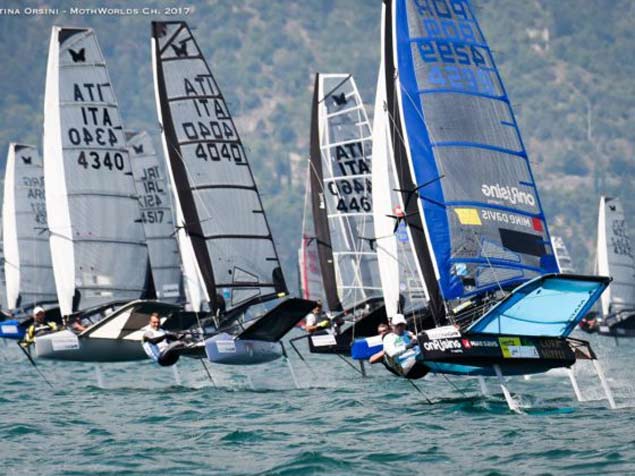 Olympic Silver Medallist Annalise Murphy led the way in signalling a change of mood for 2017 after the seriousness of her 2016 campaign towards success in Rio. In the early part of the season, she concentrated on the International Foiling Moth, and in this 223-strong fleet at the Worlds on Lake Garda in May, she became the Women’s World Champion. She is currently on a completely different direction for ten months on the Volvo Ocean Race as a crewmember on the One-Design Volvo Ocean 65 Turn the Tide on Plastic
Olympic Silver Medallist Annalise Murphy led the way in signalling a change of mood for 2017 after the seriousness of her 2016 campaign towards success in Rio. In the early part of the season, she concentrated on the International Foiling Moth, and in this 223-strong fleet at the Worlds on Lake Garda in May, she became the Women’s World Champion. She is currently on a completely different direction for ten months on the Volvo Ocean Race as a crewmember on the One-Design Volvo Ocean 65 Turn the Tide on Plastic
Of course the winning of Annalise’s medal was a matter for fun-filled celebration once it had happened, but the buildup to it was deadly serious, and that affected the tone of the national sailing mood in every area. But with the Medal in the bag, 2017 could reasonably expect to have a lighter mood, and this in turn helped us to adjust to an over-crowded programme, as crews could plan on a series of campaigns which balanced between serious events which provided proper championship results of national significance, and events which officially claimed to be providing everyone with a good time, even if some crews raced with deadly seriousness.
Either way, so much was going on that a review like this can only hope to give an impression of the season rather than a detailed analysis, but we’ll try to give it a comprehensible shape by listing the main events of Irish interest at home and abroad under either the “serious” or “fun” categorisations:
March/April: Intervarsity Championships – serious, UCD selected to represent Ireland
April: Irish Sailing Youth Pathway Nationals, Ballyholme - serious (and impressive), Ewan McMahon the star, Rush SC prominent in success
 The hyper-busy J/109 Mojito managed a hard-fought overall win in the ISORA Championship, successful participation in the Rolex Rastnet Race, and a second place in the Dun Laoghaire to Dingle Race.
The hyper-busy J/109 Mojito managed a hard-fought overall win in the ISORA Championship, successful participation in the Rolex Rastnet Race, and a second place in the Dun Laoghaire to Dingle Race.
April: Season-long ISORA Championship get under way, several venues – inevitably serious. In due course, J/109 Mojito (Peter Dunlop & Vicky Cox, Pwllheli SC) has very close overall win – despite taking time out to do the Fastnet
May: Scottish Series at Tarbert– serious, Pat Kelly’s J/109 Storm and Stephen Quinn’s J/97 Lambay Rules top their classes.
June: Howth Lambay Weekend – Fun
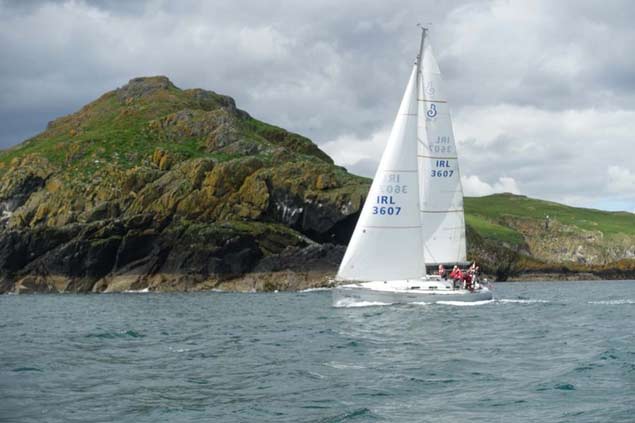 It could be a remote part of the West Coast, but Howth Yacht Club’s annual Lambay Race is a reminder that Ireland’s least-spoilt coastline is on an East Coast island. Photo courtesy HYC
It could be a remote part of the West Coast, but Howth Yacht Club’s annual Lambay Race is a reminder that Ireland’s least-spoilt coastline is on an East Coast island. Photo courtesy HYC
June: ICRA Nationals Royal Cork – probably the most serious of them all. John Maybury’s J/109 Joker 2 RIYC), Ross MacDonald’s X332 Equinox (HYC), and Paul Gibbons’ Anchor Challenge (RCYC) win the three main classes.
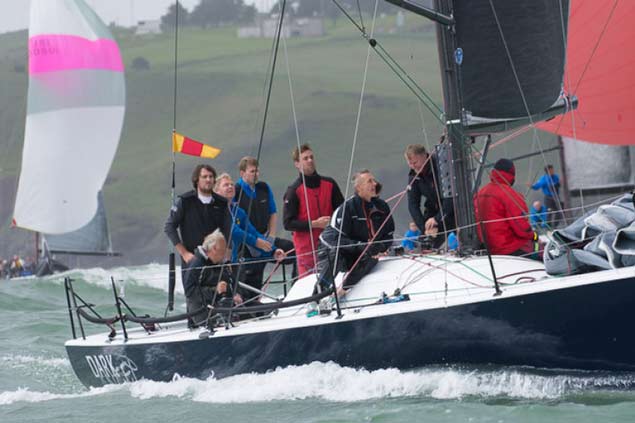 Rob O’Leary racing the Dubois 36 Dark Angel from South Wales to class success in the ICRA Nats at Crosshaven. Photo: Robert Bateman
Rob O’Leary racing the Dubois 36 Dark Angel from South Wales to class success in the ICRA Nats at Crosshaven. Photo: Robert Bateman
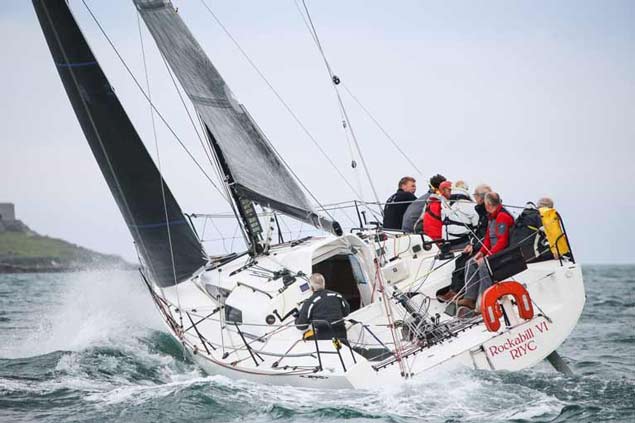 Paul O’Higgins’ JPK 10.80 Rockabill VI shortly after the start of the very tough Dun Laoghaire to Dingle Race, which she won, while a sister-ship Bogatyr was also winner of the likewise rough 608-mile Rolex Middle Sea Race in late October. This photo goes some way to revealing the reason for the JPK 10.80’s success – she is only 35ft LOA, yet you’d think you’re looking at a significantly larger boat. Photo: David O’Brien/Afloat.ie
Paul O’Higgins’ JPK 10.80 Rockabill VI shortly after the start of the very tough Dun Laoghaire to Dingle Race, which she won, while a sister-ship Bogatyr was also winner of the likewise rough 608-mile Rolex Middle Sea Race in late October. This photo goes some way to revealing the reason for the JPK 10.80’s success – she is only 35ft LOA, yet you’d think you’re looking at a significantly larger boat. Photo: David O’Brien/Afloat.ie
June: National YC Volvo Dun Laoghaire to Dingle Race – serious
June: Sovereign’s Cup at Kinsale – fun
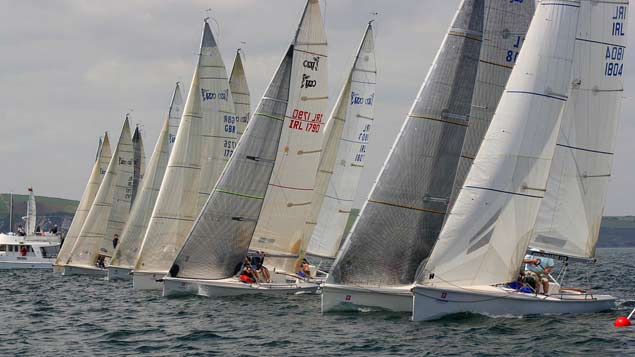 By maintaining its position as a standalone event, the Sovereign’s Cup at Kinsale can invite non-IRC classes to compete, and the 1720s responded with this keen turnout. The overall winner across all classes was adjudged to be Rob McConnell’s A35 Fool’s Gold from Dunmore East. Photo: Robert Bateman
By maintaining its position as a standalone event, the Sovereign’s Cup at Kinsale can invite non-IRC classes to compete, and the 1720s responded with this keen turnout. The overall winner across all classes was adjudged to be Rob McConnell’s A35 Fool’s Gold from Dunmore East. Photo: Robert Bateman
June: Dinghyfest at Royal Cork – brilliantly balanced mixture of serious & fun
July: Volvo Dun Laoghaire Regatta – superb, and fun
July: WIORA Championship at Aran Islands – unique
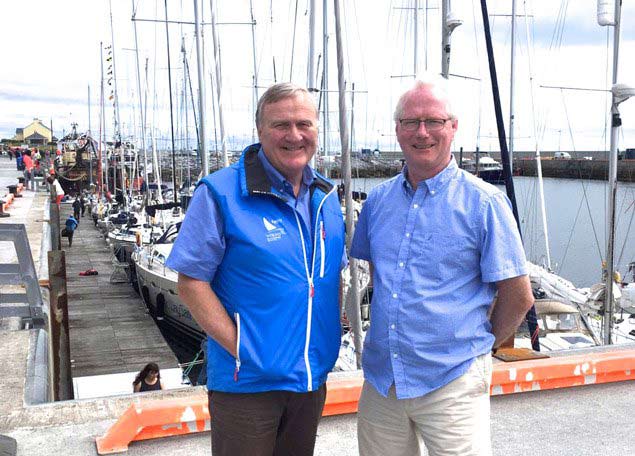 WIORA Nationals 2017 – and first time at the Aran Islands. Irish Sailing President Jack Roy (left) with WIORA organiser Cormac Mac Donncha. The popular Irish Sailing President seemed to have several doppelgangers, as that same evening he was present at the Opening Ceremony for the Volvo Dun Laoghaire Regatta, in which he also served for the entire four days as a Race Officer.
WIORA Nationals 2017 – and first time at the Aran Islands. Irish Sailing President Jack Roy (left) with WIORA organiser Cormac Mac Donncha. The popular Irish Sailing President seemed to have several doppelgangers, as that same evening he was present at the Opening Ceremony for the Volvo Dun Laoghaire Regatta, in which he also served for the entire four days as a Race Officer.
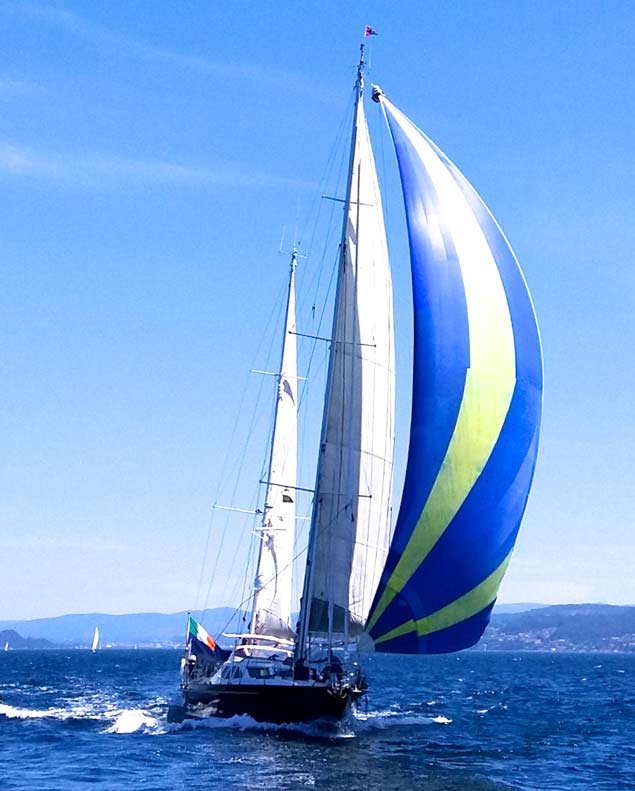 With more than sixty boats taking part, the Irish Cruising Club Rally in Northwest Spain was an outstanding success. This is Michael Holland’s 70ft 1993-built Dubois ketch Celtic Spirit – a veteran of Arctic and Antarctic cruising - making knots down the coast of Galicia. Photo: Trish Phelan
With more than sixty boats taking part, the Irish Cruising Club Rally in Northwest Spain was an outstanding success. This is Michael Holland’s 70ft 1993-built Dubois ketch Celtic Spirit – a veteran of Arctic and Antarctic cruising - making knots down the coast of Galicia. Photo: Trish Phelan
July: Irish Cruising Club Rally in Northwest Spain – seriously well organised, great fun to take part
July: Glandore Classics – fun, yet serious too
August: Rolex Fastnet Race from Cowes – serious
 Fastnet Rock astern for Jedi, the Irish National Sailing School’s successful J/109, which won class IRC 3B in the Fastnet Race, and also the Roger Justice Trophy for the top-placed Sailing School boat. Jedi is one of the 15-plus class of hotly-raced J/109s in Dun Laoghaire, whose annual championship was won by the Kelly family’s Storm from Rush SC and Howth, while the most successful boat in other events was John Maybury’s Joker 2.
Fastnet Rock astern for Jedi, the Irish National Sailing School’s successful J/109, which won class IRC 3B in the Fastnet Race, and also the Roger Justice Trophy for the top-placed Sailing School boat. Jedi is one of the 15-plus class of hotly-raced J/109s in Dun Laoghaire, whose annual championship was won by the Kelly family’s Storm from Rush SC and Howth, while the most successful boat in other events was John Maybury’s Joker 2.
August: Calves Week from Schull – prides itself on being a neat balance between fun and “quite serious racing”, and succeeds in being so.
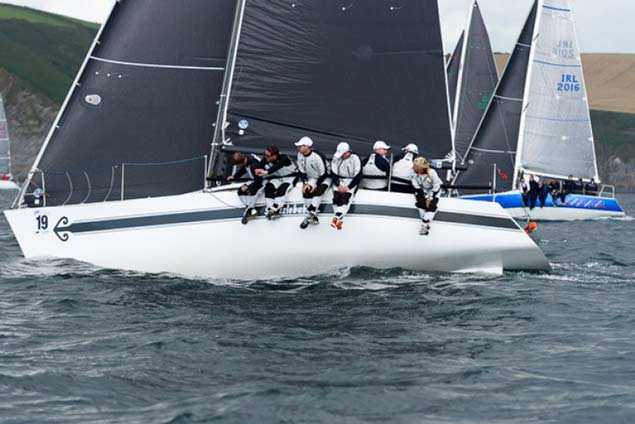 Everybody likes her, even if she beats them all. The characterful Swuzzlebubble racing to success in the Half Ton Classics at Kinsale. Photo: Robert Bateman
Everybody likes her, even if she beats them all. The characterful Swuzzlebubble racing to success in the Half Ton Classics at Kinsale. Photo: Robert Bateman
August: Half Ton World Classics at Kinsale: Supposedly serious, but in the ultimate lotus-eating venue and with such an extraordinary selection of boats, it couldn’t help but be fun. And everyone likes the slightly eccentric overall winner, the legendary Swuzzlebubble
August: Crinnui na mBad, Kinvara – traditional and fun
 The annual Crinnui na mBad at Kinvara in August may not have been favoured with good weather, but it was as popular as ever. This is one of the winners, John Flaherty’s Galway hooker Naomh Cailin, going out to race. Photo: Pierce Purcell
The annual Crinnui na mBad at Kinvara in August may not have been favoured with good weather, but it was as popular as ever. This is one of the winners, John Flaherty’s Galway hooker Naomh Cailin, going out to race. Photo: Pierce Purcell
August: Laser Nationals Royal Cork YC – serious
 RCYC Admiral John Roche, 2017 National Champion Finn Lynch (NYC) and Mark Whisker of sponsors Volvo at the prize-giving for the Volvo Laser Nationals at Crosshaven. Photo: Robert Bateman
RCYC Admiral John Roche, 2017 National Champion Finn Lynch (NYC) and Mark Whisker of sponsors Volvo at the prize-giving for the Volvo Laser Nationals at Crosshaven. Photo: Robert Bateman
September: Autumn League at Howth – fun event, but run with such serious efficiency that they’d a full programme completed after six weekends despite losing two days of racing to the late season’s poor weather.
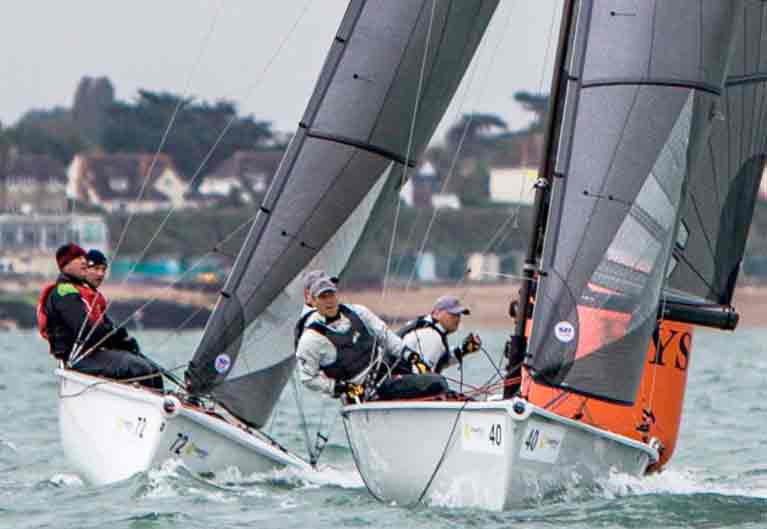 Royal St. George's Michael O'Connor, Davy Taylor and Ed Cook – SB20 'Corinthian' World Champions and Irish Champions
Royal St. George's Michael O'Connor, Davy Taylor and Ed Cook – SB20 'Corinthian' World Champions and Irish Champions
September: The SB 20 Nationals, incorporated into the first weekend of the Howth Autumn league as a three-day separate championship, had extra interest as it included recently-crowned SB 20 Corinthian World Champions Michael O’Connor, Davy Taylor and Edward Cook of Royal St George YC, who had won in the Worlds at Cowes. They added the Irish title to their 2017 trophy list.
October: Autumn League at Royal Cork - fun
October: Mini-Transat at La Rochelle – serious
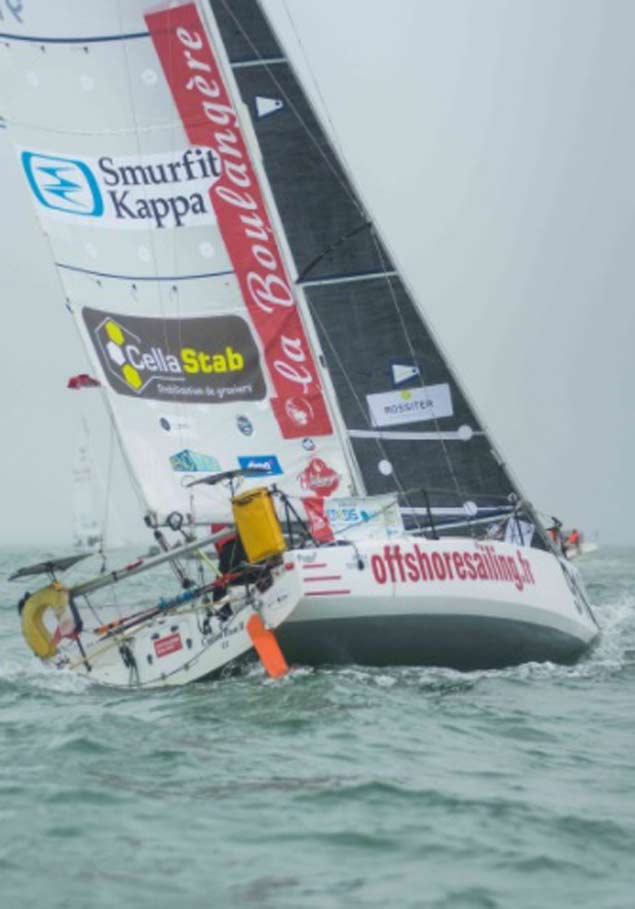 Ireland’s Tom Dolan in the first leg of the Mini-Transat 2017, 1,400 miles from La Rochelle to Las Palmas. He finished this stage 12th in a class of 55 boats The second Transatlantic stage starts on 1st November
Ireland’s Tom Dolan in the first leg of the Mini-Transat 2017, 1,400 miles from La Rochelle to Las Palmas. He finished this stage 12th in a class of 55 boats The second Transatlantic stage starts on 1st November
October: Junior All-Ireland at Schull – serious
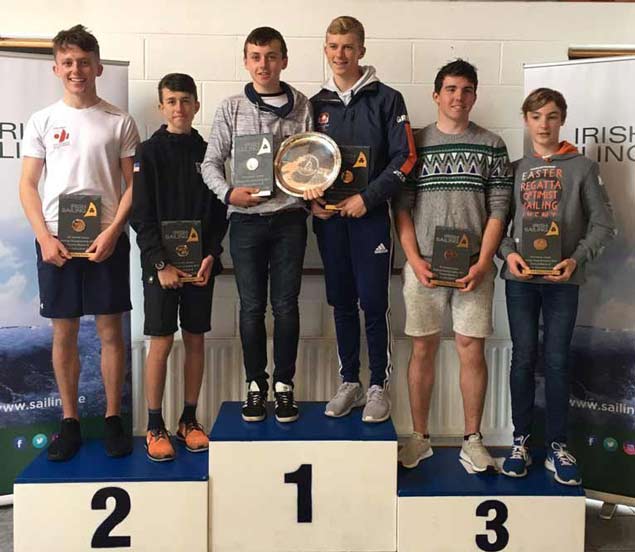 Junior All-Ireland winners on the podium. Kinsale YC’s champions Michael O'Suilleabhain and Michael Carroll, with second placed Rian Geraghty-McDonnell and Harry Durcan (RCYC) and Loghlen Rickard and Nathan Van Steenberge third. Photo: Robin Bateman
Junior All-Ireland winners on the podium. Kinsale YC’s champions Michael O'Suilleabhain and Michael Carroll, with second placed Rian Geraghty-McDonnell and Harry Durcan (RCYC) and Loghlen Rickard and Nathan Van Steenberge third. Photo: Robin Bateman
October: Senior All-Ireland Sailing Championship at Mullingar – serious and historic, as it is staged at one of the smallest, most rural clubs in the country, and raced in GP 14s.
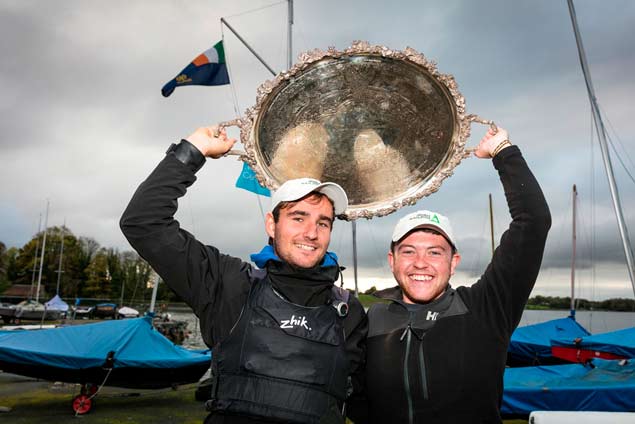 Fionn Lyden of Baltimore, All-Ireland Champion 2017, at Mullingar with the famous silver salver with crewmate Liam Manning of Schull. Photo: David Branigan/Sailing Ireland
Fionn Lyden of Baltimore, All-Ireland Champion 2017, at Mullingar with the famous silver salver with crewmate Liam Manning of Schull. Photo: David Branigan/Sailing Ireland
October: Student Yachting Worlds in Marseilles in France – serious. Ireland – a winner in times past –places fifth this time round.
October: Rolex Middle Sea Race from Malta – serious
October: Volvo Ocean Race from Alicante – serious
This fun/serious differentiation seems to have been supported by our wayward climate, which often managed to come up with good weather just when it was needed for the fun events, yet it achieved this in the midst of a generally very unsettled and often plain inclement summer.
The photos are all that is needed to show how this was so during 2017’s premier event, the Volvo Dun Laoghaire Regatta 2017 from July 6th to 9th. It wasn’t a sun-blasted regatta, but it wasn’t a wind-blasted one either – it was just a brief period of exceptionally pleasant warm weather with enough breeze for good racing , yet not too much wind to make it difficult to provide the in-harbour finishes which were introduced in special acknowledgement of the fact that they were also celebrating the Bicentenary of the massive work starting on the construction of this truly monumental and architecturally magnificent artificial port.
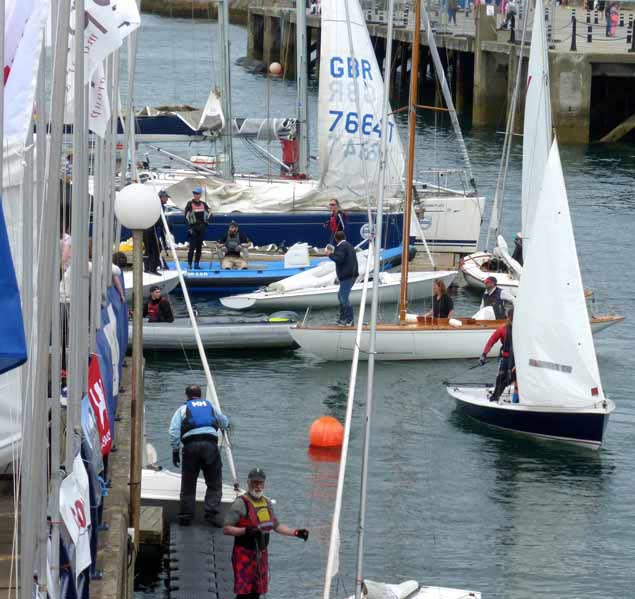 Piling them in – the good-humoured yet busy atmosphere off the National YC slipway after another day of racing in the Volvo Dun Laoghaire Regatta. Photo: W M Nixon
Piling them in – the good-humoured yet busy atmosphere off the National YC slipway after another day of racing in the Volvo Dun Laoghaire Regatta. Photo: W M Nixon
With 34 classes racing and boat numbers pushing towards the 500 mark, obviously it would have been totally inappropriate to try to include the ICRA Nats within it, as some have suggested. But even with such good conditions in its relaxed form, it could easily have got out of hand. However, with Organising Committee Chairman Tim Goodbody apparently yet always very quietly here, there and everywhere to ensure that all was running smoothly with a skillfully delegated team, it ran like clockwork to round out his two year stint in the top role with considerable style and success.
One noted visiting crew enthused that it was the best four days of sailing they’d ever had, and that was before they became aware that they’d won the ultimate trophy, the Kingstown 200 Cup, complete with a hundred guinea purse and a framed picture of the first regatta ever staged in what is now Dun Laoghaire, the Kingtown Regatta of 1828.
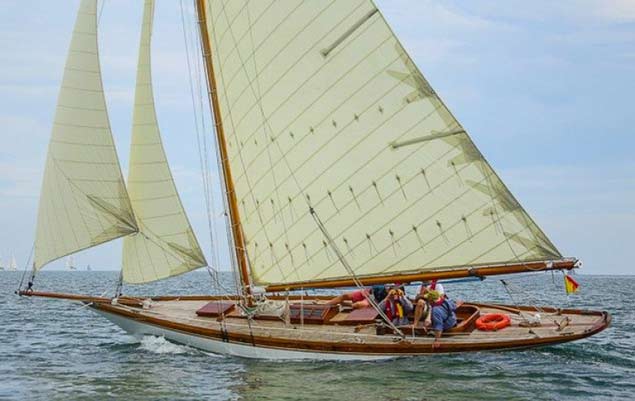 The sweetest boat in the fleet – Myfanwy from Wales - racing in the Volvo Dun Laoghaire Regatta. Photo: David O’Brien/Afloat.ie
The sweetest boat in the fleet – Myfanwy from Wales - racing in the Volvo Dun Laoghaire Regatta. Photo: David O’Brien/Afloat.ie
That was Rob Mason and his shipmates from Milford Haven with the classic 37ft Alexander Richardson-designed 1897-built gaff cutter Myfanwy, which Rob restored himself and sailed to Dun Laoghaire for the newly-introduced Classics Division, which was supposedly a one-off gesture to the Bicentenary.
But it worked so well that there’s talk of repeating it in 2019. Be that as it may, after the last race I was commiserating with the the Myfanwy team on their final placing, as I thought they’d sailed well enough to be comfortably on the podium, but Performance Echo decided others. Maybe they sailed too well. Yet far from being disappointed, they were on top of the world, and then when they went along to the huge prize-giving at the Royal St George, it was to hear to their complete surprise that the much-admired Myfanwy had been awarded the Kingstown 200 Cup and the prize purse and the historic picture……
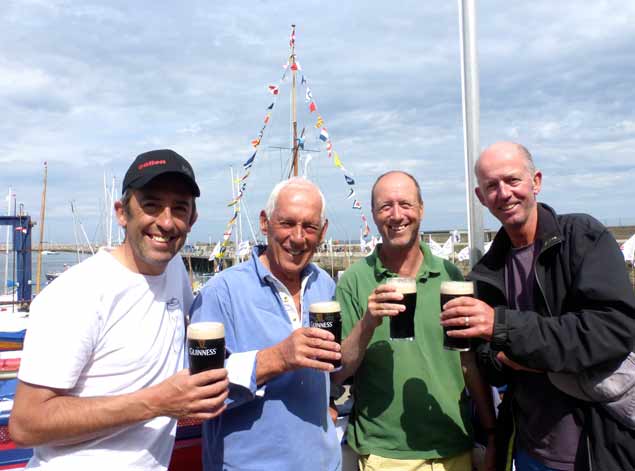 Before and after. Myfanwy’s crew celebrating “four days of the best sailing we’ve ever had” immediately after coming ashore at the conclusion of the final race in the Volvo Dun Laoghaire Regatta 2017. They are (left to right) Max Mason, his father Rob who restored Myfanwy, Andy Whitcher, and Gus Stott. The photo below shows them genuinely gobsmacked after finding they’d won the big trophy and its associated prizes. Photos W M Nixon and Gareth Craig/Fotosail
Before and after. Myfanwy’s crew celebrating “four days of the best sailing we’ve ever had” immediately after coming ashore at the conclusion of the final race in the Volvo Dun Laoghaire Regatta 2017. They are (left to right) Max Mason, his father Rob who restored Myfanwy, Andy Whitcher, and Gus Stott. The photo below shows them genuinely gobsmacked after finding they’d won the big trophy and its associated prizes. Photos W M Nixon and Gareth Craig/Fotosail

This classics success reflected a good year for the classic boats in Ireland, as six of the Howth Seventeens (1898) and a dozen of the Water Wags (1887 & 1900) made their way to the famous Sailing Week in the Morbihan in southern Brittany in May. Then at the end of July, the newest Howth 17s, Orla built in France for Ian Malcolm by the famous Skol ar Mor, arrived home, and in an epic effort in late August, in honour of Class President Hal Sisk, the continually reviving Water Wags managed their first turnout of more than thirty boats for their traditional Wednesday evening racing.
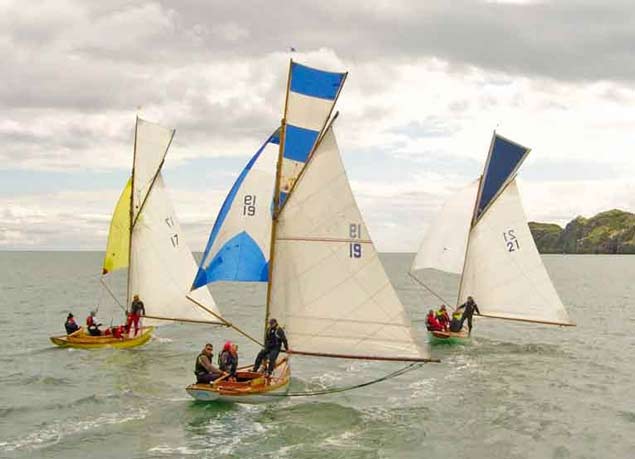 Howth Seventeens racing in their annual championship with Ireland’s Eye beyond – the new boat Orla (no 21) is on the right. Photo: Neil Murphy
Howth Seventeens racing in their annual championship with Ireland’s Eye beyond – the new boat Orla (no 21) is on the right. Photo: Neil Murphy
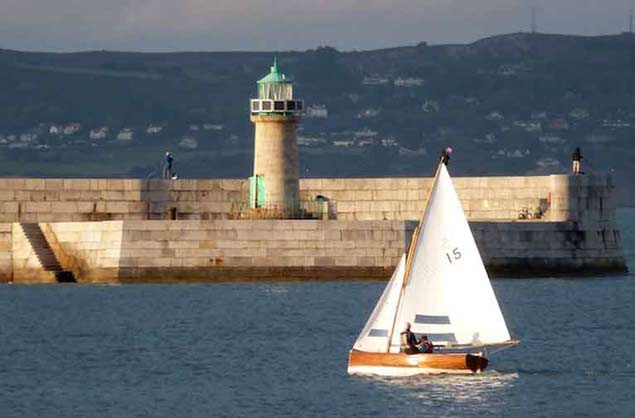 With a history going back to 1887, the Water Wags became an overnight success at the end of August when they finally managed a turnout of more than 30 boats. The clear winners were David & Sally MacFarlane with No 15 Mousmie, aged 107 years. Photo W M Nixon
With a history going back to 1887, the Water Wags became an overnight success at the end of August when they finally managed a turnout of more than 30 boats. The clear winners were David & Sally MacFarlane with No 15 Mousmie, aged 107 years. Photo W M Nixon
This has inevitably only been a skim across the events of 2017. An extraordinary season. Many hoped at the beginning of the year that it would see some relaxation after the intensity of the Olympic year, and while that may have been the overall mood, the achievements recorded above show that some sailors continued to take their own sailing very seriously indeed.
That is as it should be. But if I had to select a photo which captures the mood of 2017, the determination to make the best of it whatever the weather, then the Thomas Gautier image of Aoife Hopkins in devil-may-care mood, flying over a big sea off Douarnenez in Brittany on her way to winning the Laser Radial Under 21 European Championship, would undoubtedly be it. At that moment, Aoife was sailing for all of us.
 Sailing for all of us. Aoife Hopkins in devil-may-care style, on her way to winning the Laser Radial U-21 Euros at Douarnenez in July. Photo: Thomas Gautier
Sailing for all of us. Aoife Hopkins in devil-may-care style, on her way to winning the Laser Radial U-21 Euros at Douarnenez in July. Photo: Thomas Gautier
IRC Congress Looks to the Future
Another successful annual IRC Congress meeting was held in early October in the popular sailing venue and race destination of St Malo on the northern French coast. Forty delegates from as far afield as Japan and the USA came together to talk about the International Rating Certificate (IRC) racing around the world, technical development and ideas on encouraging participation in yacht racing generally.
In 2018, there is the exciting prospect of the IRC European Championship combined with the RORC’s Commodores’ Cup in Cowes in June, closely followed by the joint IRC and ORC Hague Offshore World Championship in the Netherlands in July. These events set the high standard for IRC racing in 2018, along with the major offshore classic races that continue to be scored using IRC.
However, the IRC Congress never loses sight of the core of the IRC fleet who are taking part in club racing around the world every week and much talk at Congress was how to further encourage this. Everyone agreed that exciting events drive participation. This is demonstrated by the record four minutes for the Rolex Fastnet Race entry to be fully subscribed and the large number of boats that entered the Offshore Worlds straight after registration opened. Clubs were encouraged to put on events that provide an escape from the stresses of modern life, with a variety of courses, and some longer races with interesting destinations.
The IRC Technical Committee has been working on technical developments including the rating of boats equipped with foils, and a longer term review on rating ‘code zero’ sails. IRC has always been fast to embrace new developments in yacht design, while as far as possible retaining the characteristic simplicity of the IRC Rule and avoiding too much complexity for the majority of owners.
The Irish Sea Offshore Racing Association’s increasingly busy annual programme is notable for the way several leading crews take in recruits from both sides of St George’s Channel, and September’s Afloat.ie Sailors of the Month (Offshore) reflect this.
Vicky Cox and Peter Dunlop, with their enthusiastically campaigned “multi-national” J/109 Mojito, feel as much at home in the National YC in Dun Laoghaire (where they are members) as they do back at Mojito’s base of Pwllheli in North Wales.
And their annual programme is one with which any offshore enthusiast on either side of the Irish Sea can readily identify, yet few could emulate their consistent success. Mojito is always in the frame. She was beaten only by the all-conquering JPK 10.80 Rockabill VI (Paul O’Higgins) in the Dun Laoghaire to Dingle Race in June, and when the leaders in the Rolex Fastnet Race were tallied as they rounded the rock itself in August, Mojito was not only the leading J/109, but she was a very remarkable 9th overall in the entire 312-strong IRC fleet.
Admittedly like sister-ship Jedi (which features in another of our September awards), she found that the Fastnet Rock to Plymouth stage of the Fastnet Race favoured slightly larger boats. But the crew of Mojito returned to the Irish Sea with their zest for competition undimmed, and took on the challenge of the final September race of the ISORA programme. It had been assumed by others that the additional challenge of fitting in a Fastnet campaign would rule them out of the ISORA title, but they somehow managed that as well, albeit by a whisker. An extraordinary year.
'Mojito' is 2017 ISORA Champion But Only After Epic Race Across the Irish Sea
A solid season for Welsh offshore campaigners Peter Dunlop & Victoria Cox was crowned in the pitch dark of Dublin Bay last night when the Dun Laoghaire to Dingle Race runners–up became overall ISORA champions.
The Irish Sea’s Wolf Head Trophy was decided in Saturday’s blustery last race of the 2017 offshore series.
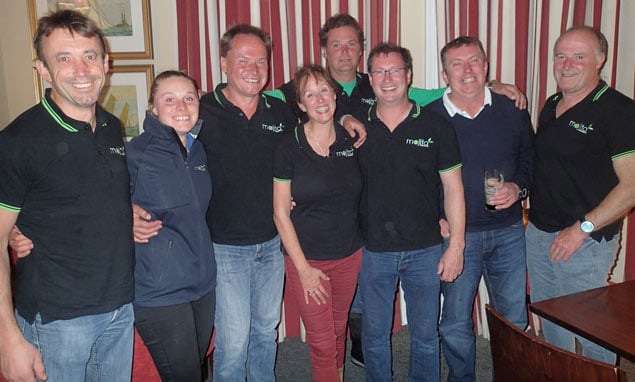 The Mojito Crew celebrate their overall win at the National Yacht Club Photo: Peter Ryan
The Mojito Crew celebrate their overall win at the National Yacht Club Photo: Peter Ryan
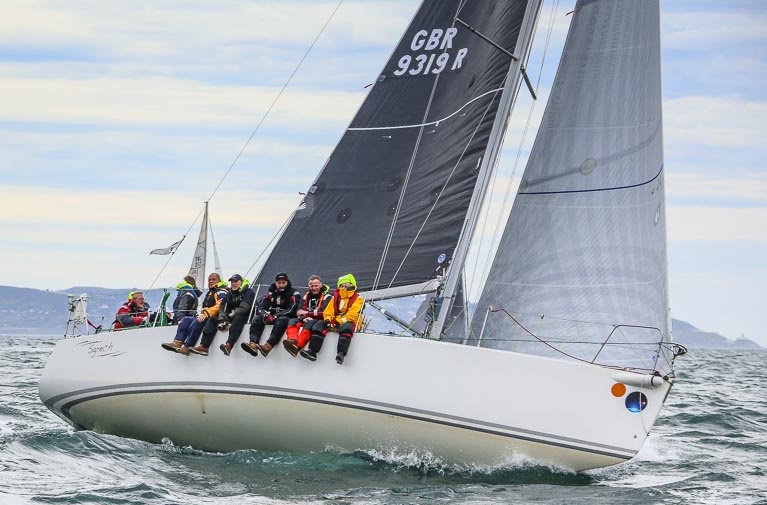 Defending Champion Sgrech (Stephen Tudor) was beaten in the final stages of the final race. Photo: Afloat.ie
Defending Champion Sgrech (Stephen Tudor) was beaten in the final stages of the final race. Photo: Afloat.ie
In an epic climax to a memorable offshore season, the outcome of the 2017 ISORA season only unfolded in the final miles of a 60–mile race from Pwllheli to Dun Laoghaire.
Just as the 37–boat season started, four dominant J109s were in the top position in yesterday's race including a Sailing School entry from Dun Laoghaire, the INSS's Jedi skippered by Kenneith Rumball.
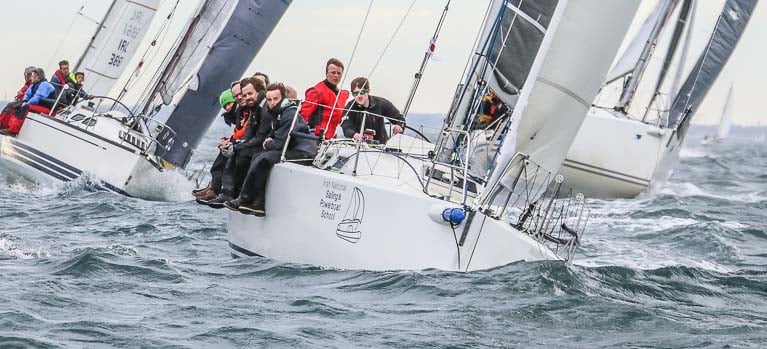 Last race winner Jedi (Kenneth Rumball) finished third overall. Photo: Afloat.ie
Last race winner Jedi (Kenneth Rumball) finished third overall. Photo: Afloat.ie
It’s been a good summer for Rumball and his INSS students, having picked up a VDLR podium place and Fastnet IRC3B victory in the first season of racing the J109.
Starting at 8am and finishing after 10pm, yesterday's tough Irish Sea Crossing – especially at Bardsey Sound – ended with Rumball's crew winning the last race, not enough to give them overall victory but a very creditable third overall in a debut ISORA season.
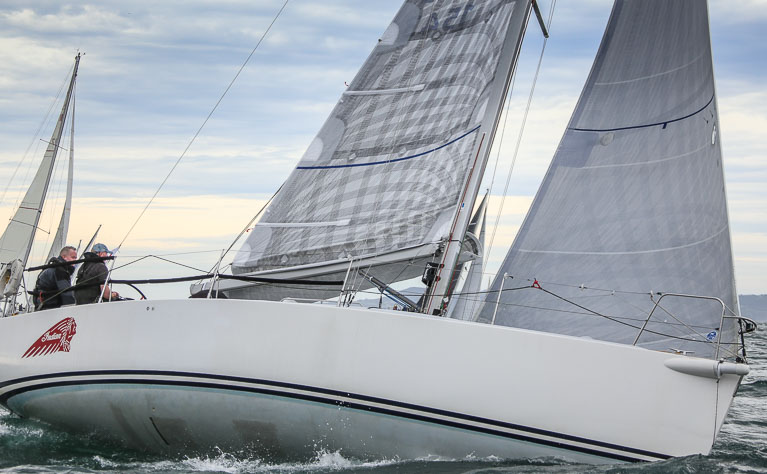 Colm Buckley's strong finish in the last race upset the overall standings. Photo: Afloat.ie
Colm Buckley's strong finish in the last race upset the overall standings. Photo: Afloat.ie
There were futher twists when Howth J109 Indian skippered by Colm Buckley getting between first Mojito and Sgrech, a result that denied the Stephen Tudor skippered Sgrech a successful defence of the coveted Wolf's Head Trophy.
Additional reportage from Peter Ryan of ISORA:
Prior to the race, Tudor’s “Sgrech” would win the Championship and retain the coveted “Wolf’s Head” if they beat “Mojito” or even if they were within one place behind “Mojito” in the results, irrespective of the placings. This tight situation led to pre-race tension.
The weather conditions for the race were not ideal with strong north easterly winds forecast providing a long beat for the fleet. Also the fact that there were spring tides on the day just made conditions worse.
The course for the race was from the Start at Pwllheli to round a local racing mark PSC2 before heading through St Tudwal’s Sound, Bardsey Sound and a long 60 mile beat to Kish Lighthouse before the final fetch across Dublin Bay to the finish between the pier heads in Dun Laoghaire.
The weather at the start was rather benign with a north easterly wind of about 15knots and a flat sea. This soon changed as the 20 boat fleet raced through St Tudwal’s Sound and into the start of the overfalls. The first leg was a tight reach. The leg to Bardsey Sound was a fetch with increasing winds and deteriorating sea conditions. As the fleet approached Bardsey Sound the wind had built to a steady 25 knots and the flood spring tide was at its strongest. Bardsey Sound is not the best place at most times but these conditions revealed the nastier side of the area. Mountainous breaking seas bounded the fleet as they were shot through the sound at speed up to 11 knots over the ground. Chris Power Smith's “Aurelia” made a short video of them exiting the Sound – their video below says it all!!
After the fleet exited Bardsey it was a full beat to the Kish Light. At this stage it was obvious that most of the J Boats were match racing with “Jedi”, “Sgrech” and “Mojito” side by side. “Jedi” eventually took the westerly leg and headed towards the banks on the Irish side. “Sgrech”, in an attempt to force “Mojito” to break cover, headed north. “Indian” and “Aurelia” were there but not heavily involved in the “match”. “Jackknife” took and immediate leg north after Bardsey.
When the tide ebbed, the fleet faced tide flows of over 4 knots against them and little progress was made until this ebb tide waned.
Most of the fleet eventually converged around the India Bank, off Wicklow, and it was obvious that the westerly leg was more advantageous. Of the boats that headed north, “Mojito” just led “Sgrech”. When the converge happened “Jedi” had made great progress and was 2 miles ahead of “Mojito”. However “Indian”, who was close to “Jedi , slipped in between “Mojito” and “Sgrech” for the procession fetch along the Codling and Kish banks and the Kish Light.
The last leg from the Kish was a fetch and there was no opportunity for any gains to be made. “Aurelia” took line honours followed by “Jacknife”. This gave Chris Power Smith's Aurelia of the Royal St. George Yacht Club first in IRC Zero class, also winning IRC Zero in the overall Series.
The main procession behind was led by “Jedi” followed by “Mojito”, “Indian” and “Sgrech”.
Due to “Indian’s” gains by heading west with “Jedi” from Bardsey, they slipped between “Mojito” and “Sgrech” to forced “Sgrech” out of their Champion position and allowed Peter Dunlop and Vick Cox and “Mojito” to be crowned ISORA Champions for 2017.
“Jedi” won the race with “Mojito” taking second, “Indian” third and “Sgrech was fourth.
An end of season party was arranged in the National Yacht Club immediately after the race. Many of the exhausted crew dragged themselves there for some light refreshments. Hon Sec of ISORA and Skipper of “Sgrech”, Stephen Tudor, made the announcement of the new Champion.
The Wolf’s Head will be presented to Peter Dunlop and Vicky Cox at the ISORA Annual Dinner, to take place on the 11th November at the National Yacht Club. The ISORA AGM also takes place that afternoon where the race schedule for the 2018 season is set by the members.
Overall results are here
INSS Sailing School is ISORA's Viking Marine Dublin Coastal Series Winner, Mojito Wins in Wales
With the completion of ISORA's race 11, the Pwllheli night race, the two coastal series, held on both sides of the Irish Sea are now complete, and ISORA has announced the winners of the two coastal series writes Mark Thompson.
The five race Viking Marine Coastal Series coastal series, held in Dublin bay, started races in both Dún Laoghaire and Howth and visited Poolberg, Greystones and Wicklow. It also incorporated the Lee Overlays Partners Lighthouse race, which this year formed part of the Volvo Dún Laoghaire Regatta offshore class, and a night coastal race. 43 boats competed in this popular series, and the winners were as follows:
Class 0 J122 "Aurelia" Chris and Pattane Power Smith
Class 1 J109 "Jedi" Kenneth Rumball
Class 2 Swan 371 "Albireo" David A Simpson
Overall Viking Marine Coastal series winner "Jedi" - Kenneth Rumball
The Global Displays Welsh Coastal Series was a three race series, which raced to all corners of Cardigan bay, and included a night race. With new sponsors this year; Global Displays, we were able to provide the fleet with yellow brick trackers which enabled the use of virtual marks, unmanned finish lines and the ability of shore based supporters to follow the races. 18 boats competed in this series and enjoyed great racing and popular social events after racing was completed. The winner are as follows:
Class 0 J125 "Jackknife" Andrew Hall
Class 1 J109 "Mojito" Peter Dunlop and Vicky Cox
Class 2 Dufour 405 "Aquaplane" Mark and Jo Thompson
Overall Global Displays Welsh Coastal Series winner "Mojito" - Peter Dunlop and Vicky Cox 
"Mojito" Co-Skipper Vicky Cox accepting the Global Displays "Midland Bowl" from ISORA Hon Secretary Stephen Tudor. Photo:Gerallt Williams
The final ISORA race of the 2017 season is the James Eadie race on Saturday 9th September which will determine the overall winner of the "Wolfs Head" trophy and confirm the three class winners for 2017.
27 ISORA Boats Expecting Light Wind Race to Greystones
A confirmed fleet of 27–boats in the ISORA day race from Dun Laoghaire in County Dublin tomorrow will most likely race south to Greystones Harbour in County Wicklow in light westerly winds.
The race is the deciding race in the Viking Marine Coastal Series and the Royal Alfred Coastal Series.
ISORA chiefs are preparing for the possibility of fickle winds under Bray Head by posting a revision to sailing instructions (downloadable below). The final course to be sailed will not be selected until later this afternoon.
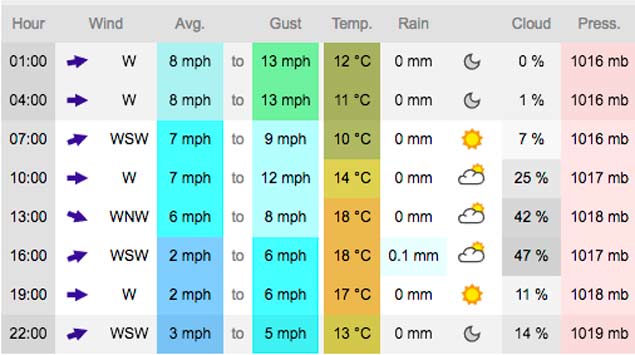 Light winds are forecast for the weekend off the east coast of Ireland
Light winds are forecast for the weekend off the east coast of Ireland
The warning signal for the burgeoning offshore fleet will sound off Dun Laoghaire Harbour tomorrow at 0955 for the 12–mile coastal race.
Organisers are emphasising that the finish line will not be the Gresystones yellow buoy but a co–ordinate immediately south of the stated position of that buoy.
 The ISORA finish line at Greystones is a coord immediately south of the stated position of that buoy
The ISORA finish line at Greystones is a coord immediately south of the stated position of that buoy
It is anticipated onboard trackers on each of the competing boats will record the finish time.
The fleet will raft up at Greystones Marina afterwards and compete in Sunday's two race Taste of Greystones Regatta, preview here.
East Coast sailing fans are expecting a big weekend for the 'Taste of Greystones' Regatta this Sunday and, as the name suggests, Greystones Regatta in County Wicklow is about a night–out followed by a morning's racing. 'The night out is guaranteed, says Greystones Sailing Club Commodore, Darragh Cafferkey, 'the racing now lies with the wind gods'.
'All this week the weather forecasts have been bouncing from five to 25–knots and from factor 50 to umbrellas', Cafferkey told Afloat.ie
It must surely be a case of third time lucky for the Wicklow initiative because the last two editions have been cut short due to lack of wind.
As Afloat.ie reported earlier this week, 55 boats are already entered – and that's ahead of 2016 numbers at this stage – to the extent that Cafferkey, himself a top Irish Sea Offshore campaigner, estimates 140 boats are expected for the raft–up at Greystones Marina in preparation for the two race series on Sunday morning that marks the end of the Summer sailing season on the East coast.
In 2013, the inaugural regatta attracted 68 boats, in 2014, this had grown to 80 and in 2015 the regatta broke the 100–mark with 2016 witnessing further growth.
 Cruiser–racers will race on two separate courses this year at the Taste of Greystones Regatta in County Wicklow Photo: Afloat.ie
Cruiser–racers will race on two separate courses this year at the Taste of Greystones Regatta in County Wicklow Photo: Afloat.ie
This year the event will be split into two courses with Class 1, 2, 3 racing on North course and White Sails in two fleets on South Course.
As Afloat.ie reported in August 2013, the regatta was originally established in a format that would attract all the East Coast clubs that don’t typically travel, it has grown in size with the following clubs all confirming feeder races.
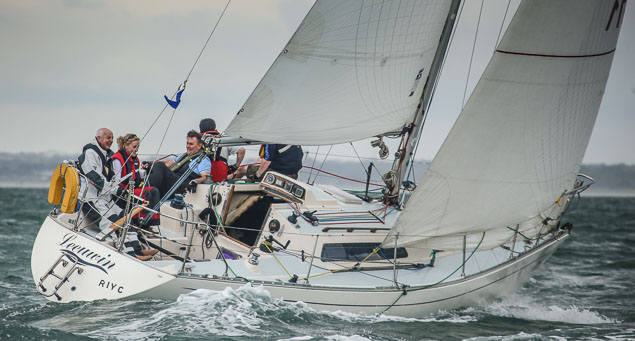 Dublin Bay's Bobby Kerr is a past competitor at Greystones sailing his Sigma 33 Leeuwin from the Royal Irish Yacht Club. Photo: Afloat.ie
Dublin Bay's Bobby Kerr is a past competitor at Greystones sailing his Sigma 33 Leeuwin from the Royal Irish Yacht Club. Photo: Afloat.ie
Wexford/Courtown will race to Arklow and join the Arklow fleet for a race to Greystones Harbour.
Wicklow Sailing Club, Bray Sailing Club, Poolbeg Yacht and Boat Club and Clontarf Yacht and Boat Club have all confirmed races to Greystones on Saturday, Caffekey told Afloat.ie
Dublin Bay will have a feeder race available for all classes and ISORA have over 25 entries confirmed for its race to Greystones.
Over ten boats from Howth have also entered meaning almost every club on the East coast plan to attend.
 Dave Cullen's champion Checkmate is a regular competitor off Wicklow Photo: Afloat.ie
Dave Cullen's champion Checkmate is a regular competitor off Wicklow Photo: Afloat.ie
A feature of the event is that it is run both on IRC/Standard ECHO and current ECHO. IRC/Standard Echo with only a few points between them means all boats regardless of certs can race based on the boat' s rating, according to Cafferkey.
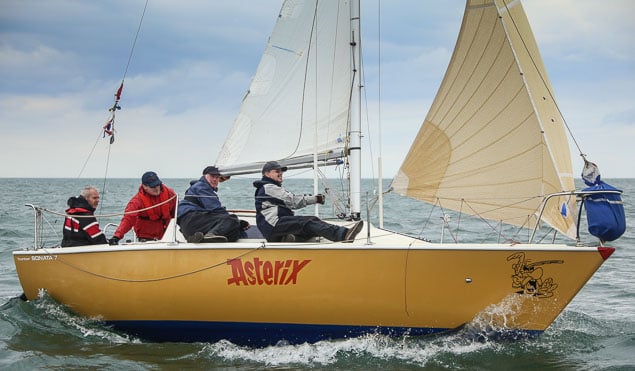 Frazer Meredith's Astrix, a Hunter Sonata, is heading for Greystones Photo: Afloat.ie
Frazer Meredith's Astrix, a Hunter Sonata, is heading for Greystones Photo: Afloat.ie
The current Echo means that the many non Dublin Bay clubs can use their own local ratings to come to a joint event . There is a limit on current echo to 3%+/- the boats standard handicap.
It is this decision four years ago that made it realistic for all East Coast clubs to come and compete. 'So prizes based on your boat and prizes based on your club performance. Something for everybody', Cafferkey says.
The support of sponsor BJ Marine has allowed Greystones Sailing Club organisers extend hospitality at its new club house that opened over a year ago on the South Pier, to include berth, BBQ, beer in Club and Beachouse plus Breakfast on Sunday. 'Throw in some Musto discounts, Water, bars and sandwiches on the water and there is little left uncovered', Cafferkey says.
First gun at Greystones on Sunday is at 10.55am.
ISORA Night Race Line Honours IRC Overall & IRC Class 0 for Royal St. George's 'Aurelia'
What has been ideal night sailing conditions for this race in past seasons was certainly not ideal last Friday night, 18th August, for ISORA’s Night Race. Weather forecasts all agreed on what faced the fleet of 18–boats that came to the start line writes Peter Ryan, Chairman of ISORA.
Four other boats had earlier pulled out. All forecasts were promising westerly winds of 25–knots and gusting. This was to remain before moderating by early morning.
Due to the conditions the Sailing Committee decided not to use the traditional turning mark on the course, North Arklow, but instead use an inshore course, keeping the fleet away from the banks. The course was: Start at Dun Laoghaire – North Burford (S) – Killiney Outfall (P) – Breeches Buoy (P) – South Burford (S) – Finish between the pier heads in Dun Laoghaire – 36 miles.
The race started in the 25 knots of westerly wind, sending the fleet fast broad reaching towards North Burford. Some of the boats attempted to hoist spinnakers but no great advantage was gained due to handling difficulties as the westerly winds gusted up to 32 knots. Daragh Cafferkey’s “Another Adventure” was first to round followed by Chris Power-Smith’s “Aurelia”.
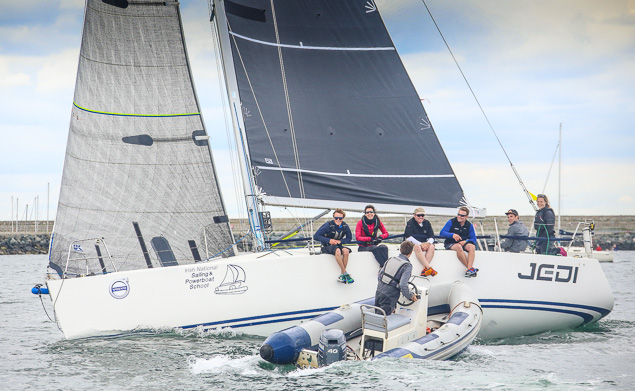 Just back from a top showing at the Rolex Fastnet Race, Kenny Rumball's Jedi from the Irish National Sailing School competed in ISORA's night race and won Class One Photo: Afloat.ie
Just back from a top showing at the Rolex Fastnet Race, Kenny Rumball's Jedi from the Irish National Sailing School competed in ISORA's night race and won Class One Photo: Afloat.ie
The next leg was a loose fetch / tight reach down to Killiney Bay. The fleet had split at this stage. “Aurelia” had passed “Another Adventure” to round that mark first. Close behind the leaders was Kenneth Rumball’s “Jedi” of the INSS and Roger Smith’s “Wakey Wakey” and Vincent Farrell’s “Tsunami”.
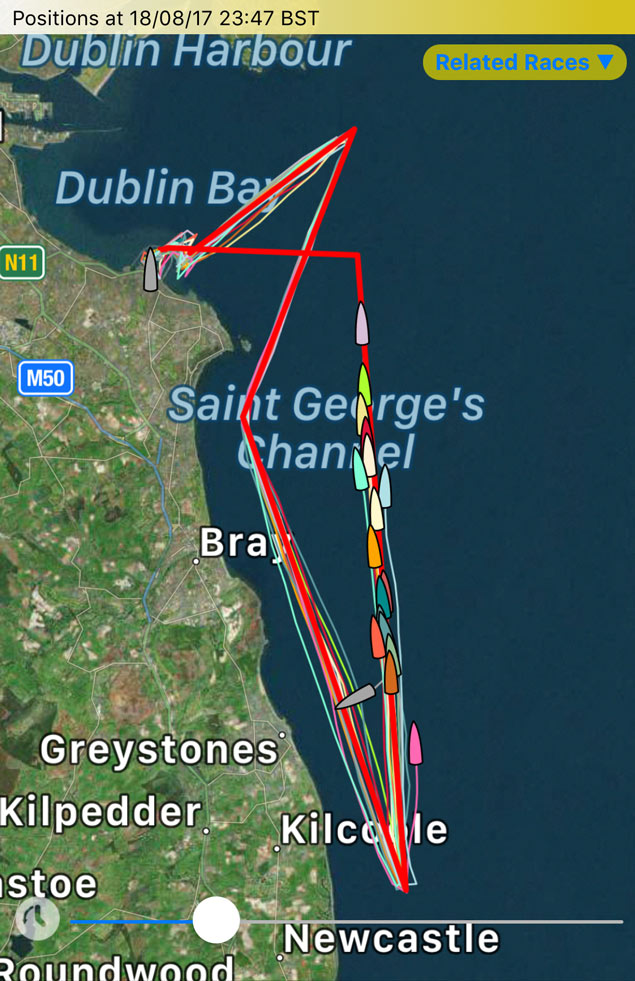 18–boats came to the start line for the ISORA night race along the Dublin and Wicklow coast
18–boats came to the start line for the ISORA night race along the Dublin and Wicklow coast
The next long leg south to Breeches was another broad reach but this time those boats who ventured to hoist spinnakers broke away from the fleet, despite the many broaches. Rounding Breeches Buoy, “Aurelia” still was maintaining its lead just ahead of “Another Adventure”.
The following leg was a fetch north to South Burford. “Aurelia” had by this time extended its lead from “Another Adventure” followed by “Jedi”, Colm Buckley’s “Indian”, “Tsunami” and Paul Egan’s “Platinum Blonde”.
The last leg to the finish was a beat. “Aurelia” continued to extend his lead and took Line Honours, IRC Overall and IRC Class 0. “Jedi” just pipped “Another Adventure” by 26 seconds to take 2nd IRC Overall and IRC Class 1. Derek Dillon’s “Big Deal” took IRC Class 2.
In ECHO, Jim Schofield’s “Thisbe” took Overall and Class 2. “Aurelia” took Class 0 while “Jedi” took Class 1. Full results can be found here
The next race takes place next Saturday, 26th August, a day race from Dun Laoghaire to Greystones. This is one feeder race to the Greystones Regatta to take place the following day. A fleet of 25 boats from a list of 33 entries are expected to make their way to the start line.
 J109 Mojito holds a narrow lead in the overall Avery Crest Offshore Championship going into the Dun Laoghaire–Greystones race this weekend. Photo: Afloat.ie
J109 Mojito holds a narrow lead in the overall Avery Crest Offshore Championship going into the Dun Laoghaire–Greystones race this weekend. Photo: Afloat.ie
The Overall Avery Crest Offshore Championship is hotting up with “Mojito” slightly ahead of the current Champion “Sgrech” and followed closely by “Jedi” and “Aurelia”. With a large fleet expected for the last offshore from Pwllheli to Dun Laoghaire on the 9th September, it is possible for any one of those boats to snatch the coveted “Wolf’s Head” trophy.
With many ISORA boat competing in the Fastnet race, a smaller than normal fleet of ten came to the start line in Dun Laoghaire on Saturday 5th August, with useful points in all three classes up for grabs writes Mark Thompson.
An early 08.00 downwind start under spinnaker in a 10kt south westerly which was forecast to reduce from the west during the day. There were many issues to contend with, a strong Irish Sea tide, and crucially the infamous Bardsey "tidal gate" which was in favour until 1530 or so and becoming slack until 16:30 After that with a strong tide against wind, progress through Bardsey would be a challenge!
Andrew Hall's J125 "Jackknife" relished the conditions and had no issues making the Bardsey gate, and enjoyed a great run across Hell’s Mouth recording speeds of 10kts or so and took line honours in an elapsed time of 9 hrs 41 mins followed by J122 Aurelia.
Chasing hard behind and making the Bardsey gate with 20 mins to spare, overall IRC winner yesterday J109 “Sgrech”, who carried the same spinnaker for the entire race, and only gybing three times. Stephen Tudor, skipper of “Sgrech”, described the whole race like a game of chess, with so many variables at play! Indeed J109 "Just Jay", just a couple of miles behind “Sgrech”, was forced to make several sail changes during the run to Bardsey, costing many minutes ! Second overall was Howth based J109 "Indian" who enjoyed their first Pwllheli race immensely. Mid fleet finishers recorded elapsed times of 12 -14 hours and managed to dodge the worst of the ebbing tide.
At the rear of the fleet in Class 3 "Elandra" and "Oystercatcher" missed the gate and took some time against the strong tide to get clear of Aberdaron bay. However "Oystrcatcher" elected to go round south of Bardsey meeting up with "Elandra" off Hell’s Mouth , and both finally finished between midnight and 1am. A great performance by these two class 2 boats who got valuable points in this class, with Sigma33 "Elandra" now leading this hotly contested class.
All competitors were warmly welcomed to Plas Heli, the Welsh National Sailing Academy, Pwllheli. Although busy hosting the Topper Nationals, the "Pwllheli Sailing Club" prepared a special ISORA "Sailors Stew" and jugs of beer for the weary crew. A great night was had by all and everyone connected with ISORA agreed it was another excellent Race.
This spices things up for the overall Wolf's Head trophy and it looks once again it's going to be a match race during the James Eadie race on the 9th September, between current Champion “Sgrech” and Mojito.
The Lyver Race, after the postponement from the 30th June, took place on Friday 21st July writes Peter Ryan, Chairman of ISORA. The race is also an ISORA, RORC and a qualifier for the Fastnet Race. While 32 boats had entered the race for the original date, only 13 boats came to the start line in Holyhead last Friday.
The weather forecast for the race was for light to moderate southerly winds to back to westerly during the night and early morning. There was also strong tides.
The race start was provided by Liverpool Yacht Club committee boat at the Clipera buoy outside Holyhead Harbour. The course was as follows: Start - TSS Area (P) – M2 (S) – Rockabill (P) – Kish Light (S) – South Burford (S) and Finish between the pier heads in Dun Laoghaire – 100 miles.
The area of the TSS (Traffic Separation Scheme) was identified by a series of coordinates and all boats were to keep out of this area.
The downwind start saw “Rockabill VI” and “Jackknife” making a clean start and leading the fleet north in a light easterly breeze. Immediately behind these were the three J109’s “Sgrech”, Mojito” and Jedi”. These boats continued to match race for the entire 100 miles.
Rounding the top of the TSS the fleet were still under spinnaker as they headed towards M2. On this leg the fleet split with “Jackknife” and “Rockabill VI” taking a southerly route and the other maintaining a more northerly line. Even after the M2 the fleet were still under spinnaker and as the fleet approached Rockabill it was evident that the northerly line was paying off. The winds remained south easterly and had not backed as forecast.
“Jackknife”, although first around Rockabill, had not made sufficient distance from the following fleet and “Mojito” followed next and was leading the fleet. At that stage only three boat lengths serapated “Mojito” from “Sgrech”. “Jedi” had fall a small distance behind.
The leg to the Kish was a fetch against the tide. On this leg “Sgrech” just managed to inch in front of “Mojito” and rounded the Kish ahead of them. The last leg in towards Dun Laoghaire was a full run in slackening easterly winds and against the now ebbing tide.
“Jackknife” took line honours and Class 0 IRC but only managed 4th Overall IRC. “Sgrech” managed to hoild the slight lead into the harbour, finishing just 2 minutes 26 seconds ahead of “Mojito” but enough to give “Sgrech” the Overall IRC Win and Class 1 IRC. “Elandra” took Class 2. In ECHO, “Jackknife” took Overall and Class 0 while “Sgrech” too class 1 and “Elandra” took Class 2. Full results can be found on www.isora.org
The wind by “Sgrech” reduces “Mojito”’s lead in the Overall Wolf’s Head series. However with “Mojito” heading off the compete in the Fastnet Race, they will miss the next offshore on the 5th August and their lead may reduce even further. All this opens up the competition and may develop a repeat of last year when the Overall Series was dependant on the results of the last race. The last Offshore is the Pwllheli to Dun Laoghaire race on the 9th September.
The presentation of the Lyver Trophy and RORC medallions will take place at the ISORA dinner in the National Yacht Club on the 11th November.


























